Margot Note's Blog, page 22
October 4, 2021
Considerations Used to Appraise Archival Records
What is the value of the information contained in archival materials? To determine this, archivists concentrate on the circumstances of creation.
The focus is on identifying the role and significance of the records creator and the position that the records creator held within the organization. The records of a high-level person in an unimportant function may be less critical than lower-level records documenting a vital function. Archivists consider the creator’s position in the organization, the unit activities, and the record function.
ContentArchivists also analyze content. Archivists need to know not only to whom and to what function these records relate, but also how well they cover the relevant period, whether the records are of quality, the extent of the information, and whether there are any mitigating factors that limit that content’s value. Archivists consider the practical limitations of the records, like legibility and understandability, and topical analysis, such as time span, level of detail, creator’s relationship to the topic, and the character and quality of the information.
Archivists ask the following questions:
What is the records’ provenance?
What do they document?
Is there a relationship between the records and the collections already within the repository?
Do the records duplicate collections already in the repository? Or elsewhere?
Do the records fit the repository’s mission and collection policy?
Do the records fit into the archives’ documentation strategy?
UseArchivists also consider the use of the records. Archives must always consider the repository’s user base and how this group of records does or does not fit. By audience, archivists mean primary and secondary users, and prospective as well as current users. They consider the user interest such as clientele and research trends methodologies, as well as access restrictions.
Archivists may ask:
What legal guidelines or restrictions apply to the records?
How do retention schedules apply to the records?
What restrictions apply to the records?
What is the anticipated use of the records?
CostsThe costs of retention are considered as well. There are costs—and not insignificant costs—attached to accepting materials. Archivists often do not think about anything beyond space. Regarding storage, not all space is the same; some materials require oversize shelves or map drawers or different environmental conditions.
How much will it cost to process the materials? Frequently archives assign processing tasks to interns, students, or paraprofessionals, but that is not always a practical approach for certain kinds of materials. (Plus, in my opinion, having non-archivists regularly perform processing devalues the profession and the incredible amount of intellectual labor involved in our work). Some types of records require subject expertise and not just archival knowledge. Other files take the standard folders and boxes while different types of material require additional equipment or materials. Of course, some materials arrive in better order than other files and require less work. Archivists, therefore, think about the level of expertise needed, the cost of supplies, and the quantity of work.
Conservation may be required for a collection. Some materials arrive in good condition and need little more than re-foldering and boxing. Other materials are fragile and cannot be handled without additional preservation work, which is costly in time and materials.
Another factor is reference services. In some respects, the level of work entailed in providing reference depends on how well the collection has been arranged and described. But sometimes, the nature of the material relative to the way researchers need to access it makes the process very labor-intensive.
A Balancing ActThe implication of the appraisal process is where reality comes into play. Archivists can account for all aspects of the value of the information, and they balance that against the cost of arranging, describing, preserving, and making accessible records of enduring value.
The blog was originally published on Lucidea's blog.
Get StartedLooking for archival advising, records management, and historical research services? Click below to speak with an expert consultant.
Contact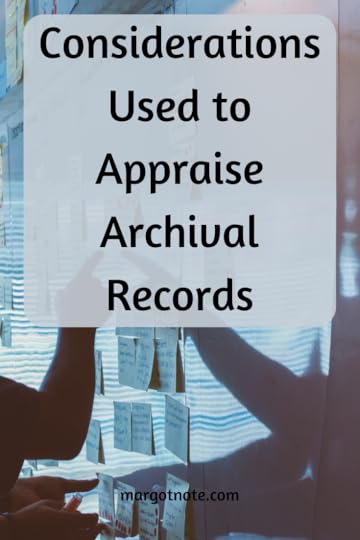
September 27, 2021
Managing Electronic Records in Archives
The management of electronic records is based on traditional archival and records management theories and practices adapted to the digital environment. A noticeable difference is that the preservation of records begins earlier in the digital environment.
For example, a fundamental assumption in archives is that physical documents can be stored for decades without additional attention and be fine; they can suffer from benign neglect and be usable. Conversely, digital objects need constant attention to remain functional over time. They provide an informed discussion of the definition of a record, which is evidence of an activity, and what constitutes an activity.
Lifestyle ManagementThe management of an information asset is often called lifecycle management. Lifecycle management is the idea that records have a life from their creation to their end—whenever that might be. For records management, at the end of the lifecycle, the documents can either be legally destroyed or, if they have enduring value, be preserved as archival materials.
The organization of records also serves as evidence of transactions as well as information resources. Their organization takes place on many levels, from what information assets exist organization-wide, down to how they relate to which documents need to be retained to document each business process. A vital aspect of the organization of records is the need to maintain relationships among the documents and understand their provenance.
Dual PerceptionsTwo competing views of a record’s life exist: the records lifecycle and the records continuum. One might ask which is better? As well as better for what? Non-archivists find the lifecycle easier to understand because it clearly explains their role in the life of a record and, most importantly to them, when their role ceases and they transfer the management of their records to someone else. Archivists prefer the continuum because it gives them a role in managing records early in the process, which is extremely important in managing electronic records.
The Process ModelAnother way to view records is through the process model. The process model shares with the continuum model the concept of continuous management of information assets—rather than specific sequential management stages that underlies the records life cycle. However, the process model adds four ideas of its own that are sometimes lost in the simplicity of the continuum model. Archivists should review them in terms of the long-term access of digital objects.
The first aspect is planning. The process model stresses the need to prepare for managing records at the beginning of the process if management activities are to operate successfully and efficiently. Planning for how the organization will maintain digital objects for the required time, sometimes decades, is essential. How will archivists ensure the preservation of authenticity and integrity of the records over time?
Another factor is the complex nature of management. The process model identifies the numerous activities that are part of managing records: assessing (assigning values including archival appraisal), preservation, and retrieval, and use, leveraging, and repurposing. Each of these activities needs to be identified and tracked. For example, if records will be reused, then ensuring integrity becomes a significant issue.
The third issue is the changing nature of management. As the uses of records and requirements for them change, archivists and records managers need to be involved. If records are migrated from one system to another, information professionals must ensure that the integrity of the records is maintained.
Lastly, one must consider the broad range of people involved in management. The process model does not assign roles or persons to these activities because the management of records involves many individuals, and their roles may change over time. In electronic recordkeeping, management will include the system owner, users, archivists, records managers, IT, and other departments, such as the legal office, depending on content.
Benign Neglect No MoreWhatever model is used, information professionals, including archivists, have a stake in controlling an organization’s records from their creation until they are archived or destroyed. Where the archivist intervenes depends on the nature of the document. While physical records can receive inattention for years, even decades, electronic records cannot. Preserving valuable information assets requires identifying records, classifying them, and storing them, as well as coordinating internal and external access.
The blog was originally published on Lucidea's blog.
Get StartedLooking for archival advising, records management, and historical research services? Click below to speak with an expert consultant.
Contact
September 20, 2021
How Electronic Records and Physical Records Differ
Most archivists would agree that an electronic record is a record in electronic form and a record is a record, regardless of how it is created or the medium on which it is stored.
According to the ISO 15489, “electronic records are those recorded on electronic storage media and produced, communicated, maintained, or accessed by means of electronic equipment.” Note that the definition of an electronic record does not say much about what it is other than a record on electronic media.
There are two differences between traditional and electronic records. Although there are electronic counterparts for paper records, there are many electronic records for which there are typically no hard copy counterparts. In addition, having records in electronic form changes the way people use, value, manage, and preserve them.
Traditionally, those with an archival or public sector background have one perspective, while those who have worked in records management or the private sector have another. Although this is an overly broad characterization, it has a basis in fact. How people view records depends on their backgrounds and the organizations that employ them.
Defining a RecordDefinitions of a record abound. Each has its value, and the reason for all the examples is that different people will take different views of what a record is, and therefore, it is worth knowing what the permutations are, since how one defines records demonstrates how one seeks to manage records.
The ISO definition of a record (and electronic record) is the world standard. Other definitions remain, partly for historical interest and partly because they offer some useful insights. According to the ISO, records are documents created, received, and maintained as evidence and information by an agency, organization, or person in pursuance of legal obligations or business transactions. The definition further states that records have four defining characteristics:
Authenticity means that content, context, and structure persist.
Reliability stresses that the records are trustworthy.
Integrity means that the records are complete and unchanged.
Usable means that records can be located, retrieved, presented, and interpreted.
Archival RecordsThe definitions of records have three parts. First, archivists need to know what the record is. Most people focus on a record being evidence of a transaction. It is also a container of information, information relating to what the record is evidence of, and other uses, such as secondary value in archival terms. Next, a record depends on its characteristics, such as content, context, and structure. Lastly, what is the value of the record? Some definitions include why the record is preserved or maintained—evidential or informational values, for example. Others do not. Being evidence of a transaction and having characteristics such as reliability are nice but managing them costs money, so decision-makers need to know why they are spending money to preserve these records.
Each of the standard part of the definition poses its own set of questions. For example, if a record is evidence of a transaction, then what is a transaction? Since records cost money to create and maintain, what transactions need to be documented and what records must be retained to do so?
Records are supposed to have characteristics such as integrity, meaning that the record is complete and unchanged, but that characteristic needs to be demonstrable by providing evidence that it is complete and unchanged. That requires management, and management costs money. How do you demonstrate that? For example, must everything be digitally signed to be demonstrably authentic?
Lastly, who decides what records need to be retained and for what purpose?
The Archivist’s RoleThe definitions of records—electronic or physical—will continue to be debated. A better way to define records is to ask what the asset is a record of. What type of transaction does it document? Who considers it a record? Who has a stake in it and its creation and maintenance? Why is it being maintained? What purposes are served by maintaining it, and at what cost?
Answers to these questions will give archivists a basis for deciding to concern the asset’s value and how it needs to be managed. Archivists contribute their expertise to managing a broad range of records that need to be preserved.
The blog was originally published on Lucidea's blog.
Get StartedLooking for archival advising, records management, and historical research services? Click below to speak with an expert consultant.
Contact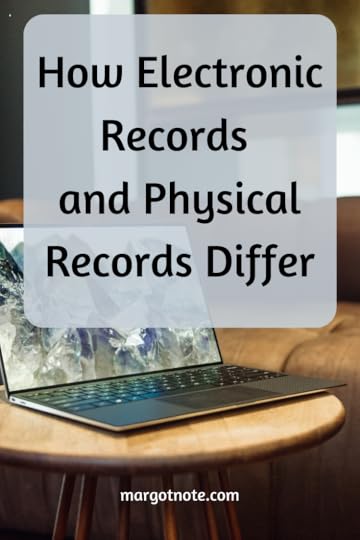
September 13, 2021
Archival Description and Cataloging
Archival description, primarily, is a way to bring order to the chaos of unprocessed records of enduring value.
Description is not just what archivists do to an individual collection. Description begins when the collection first comes into a repository—when archivists accession collections into a repository’s recordkeeping system. Archival description is incremental and progressive, and proceeds in a continuum. As archivists work further on a collection, they can provide more detailed and comprehensive information. Archivists are also able to provide a broader range of access points, both local and remote.
Cataloging DifferencesThere are significant differences between library and archives cataloging. For example, holdings are similar from library to library, allowing for copy cataloging. The library catalog leads the user directly to the item; the archival catalog leads the user to the finding aid, which is a surrogate for the collection. Archival terminology is confusing, so it is harder to develop a system that researchers can use without interventions by staff members. Archivists are dealing with an environment with increasing expectations that everything is on the Internet, an achievement that is much more difficult for archives.
There are many differences between archival materials and library materials too. For instance, there are physical differences between discrete volumes with ready-made data and boxes of unlabeled papers in folders. Differences exist between items consciously created to be used by others and materials accruing over the course of activity. There are also differences between the library focus on subject and content and the archival focus on context and source.
Limitations of MARCWhile finding aids describe collections at many levels, MARC records often represent single-level records for inclusion in integrated library systems and bibliographic utilities, such as WorldCat. The presence of archival materials in these records has enhanced the reach of these records.
The relationship between the MARC record and finding aid is an important one. For any level of description created in a finding aid, a cataloger could create a corresponding MARC record, although only at one level. Therefore, MARC records become a summary for a particular level of description.
The distinction between single-level and multilevel descriptions is a fundamental construct for archival description. Single-level description allows catalogers to describe archival materials at any level, from collections to single items and any level in between. They can, however, only describe that material at one level. Multilevel description, in contrast, represents at least one sublevel. This distinction provides archival catalogers flexibility.
MARC captures data describing a discrete bibliographic item; complex collections requiring descending levels of analysis overburdened this structure. While adoption of MARC was well underway, archivists needed more to satisfy the multilevel characteristic of archival description.
Accessing CollectionsThe chief information source for the catalog record is the finding aid and other administrative information, not the collection itself. If archivists went back to the actual collection for the cataloging, they run the risk of producing access points that the inventory does not reflect. Users could find call phantom entries in the catalog and then be unable to locate information related to the access point in the finding aid. Access points should lead directly to the information that clarifies the access point.
Catalog description is one component of the overall finding aid system. There has been discussion as to whether, with the Internet, archivists need to have a system at all. Users, for example, can enter search terms into Google and discover archival inventories. This approach is unsatisfactory and does not help a repository manage its holdings.
In addition, the finding aid systems serve internal as well as external purposes. Researchers and archivists use the catalog to locate a particular collection or find everything an institution has on a topic. Users can then move from the summary catalog description to the inventory or surrogate and then to the collection. The catalog still serves as a portal to archival materials.
The blog was originally published on Lucidea's blog.
Get StartedLooking for archival advising, records management, and historical research services? Click below to speak with an expert consultant.
Contact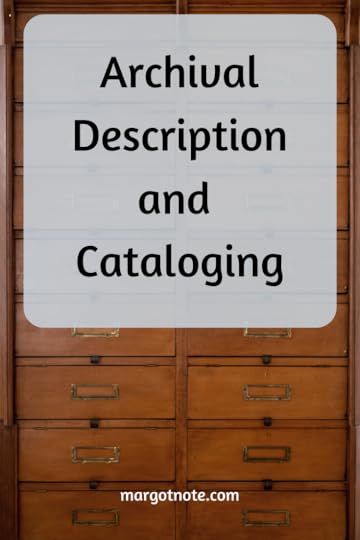
September 6, 2021
Change and Continuity with Analog and Digital Records
Two major events affecting archives and records management have occurred. The basic principles, while still valid, need to be adapted to the contemporary information environment. The world in which archival procedures implement those principles has changed.
Technology has complicated the processes for creating and managing records, and the environment in which archival management takes place has changed as well.
Past PracticesPhysical archival practices were built on the model that incorporated the following principal points. Firstly, recordkeeping procedures explained at a business process level what documents needed to be included in official files for each business process. There were also gatekeepers, such as secretaries, file clerks, and file custodians who were trained in records management and who knew how to interpret the rules and storage areas for the official files. In addition, records were routed through these custodians, who kept all the official files in central locations.
Anything not in the central file was not an official record. Materials that were not considered to be official records were left to individual employees to manage. The assumption was that these had no broader organizational value and employees could manage them as they wanted, provided that the records did not overflow the space in the employee’s cubicle. Is it no surprise that archivists often find that employees take records home and keep them in the basement or garage?
Keeping Up with TechnologyThere are business processes in which these principles still hold, but many business processes are not well enough defined to achieve this level of management. Employees do not do this very well for many reasons, but principal among them is that they do not believe managing information is part of their job. Clear guidance is lacking. Records management practices have not kept up with the technology that creates records. For example, archivists and records managers now create policy via wikis, but the guidelines speak about collecting and analyzing comments on drafts circulated for review. Employees find records management software complicated and hard to use and frequently refuse to use it.
A basic example of the problems information professionals face in archives and records management is that traditionally the informational value of records expired before its legal or administrative value did. Exceptions existed, but it was not easy to repurpose and reuse since the information was frozen in hard copy form. Hence it was considered disposable. It was also more controlled because if nothing else, one had to create hard copies of anything to be distributed, and that took work. Assigning retentions and dispositions to records met little resistance from employees, who did not find the older records useful.
The Game ChangerEverything changed with electronic records. Electronic records are easy to disseminate and remain useful as reusable information long after their legal and administrative values may have expired. Add to that the ability to store vast amounts of information on small storage devices and the lack of any uniform process for identifying and describing records. Copies and versions may abound for documents, with no clear information identifying the final document. As a result, archivists and records managers now face gigabytes of undescribed, unstructured data and documents sitting on shared drives and removable media. At one point that may have been an irritant, but not a significant problem. But in an increasingly litigious society, worried about compliance, these unmanaged records or information assets are either unexploited resources, unexploded land mines, or both. The pressing need to find ways to restructure information management to meet the challenges of the twenty-first century is why the field remains of interest.
The blog was originally published on Lucidea's blog.
Get StartedWork with an archival expert. Learn more about how I might help you by clicking the contact button below.
Contact
August 30, 2021
Providing Access to Archival Collections
Archivists have always cataloged their collections. In the past, repositories had card catalogs and catalog level descriptions in published repository guides.
Some catalogs followed library rules of the time, and some followed idiosyncratic styles. The one-of-a-kind nature of archival materials guided the descriptive tools—such as finding aids, registers, or inventories—created to provide access to them.
The excuse for the lack of consistency was that archival materials were unique. In addition, the advantages of copy cataloging, which drove library standards, were irrelevant to archives.
Information professionals at libraries and archives experimented with various computer applications before concluding that the Machine Readable Cataloging (MARC) format, as a structure standard, could serve the archival profession. There had been hopes that archivists could develop their descriptive standards, but the size of the profession and lack of resources made that unlikely.
So, while archivists have always cataloged, MARC forced archivists to regularize what they did in a couple of ways. Archivists had to define data elements, and they had to shift their approach to encompass the online catalogs and coordinate with other parts of the institution. These actions helped archivists learn library cataloging rules, including authorities for access points which led to more consistency.
Archival CatalogingThe descriptive catalog record is a surrogate for a cultural entity, but the catalog record differs from that for published works. In published works, the cataloger can transcribe predictable data elements, such as title and imprint information.
Instead, archivists must decide what to include in the record with archival materials, which comes from an understanding of their nature. They also must determine what features are significant enough to highlight for users in terms of the narrative parts of the record and the access points that connect users to that record.
As archivists moved beyond standard textual records, they ran into complexities. For example, with audiovisual materials, the physical characteristics are defined, such as recording, speed, tape density, and encoding format.
In general, cataloging archival materials is different from cataloging library materials because provenance or source defines the context and not publication data. In addition, information is abstracted, interpreted in terms of the material’s origins, arrangement, scope, and content.
It is also important to remember that archival principles apply. For example, collections, not items, are the units of analysis. Archivists can highlight individual items when appropriate, but archival description focuses on the aggregate.
Physical and Intellectual ArrangementCollections can be physically and intellectually subdivided. Archivists identify or create and describe intellectual groupings within a collection. They start with the intellectual groupings and then have the physical arrangement follow that framework.
Archivists can create descriptions at any level of the intellectual hierarchy. Archivists describe at the collection level in terms of the biography of the creator or the history of the organization and the scope and content note. The level of description is usually what transfers from the inventory to the catalog level description. The main level of narrative description about the collection itself usually comes at the series level. The physical description that helps researchers identify the containers to request comes at the file unit level.
A Descriptive DichotomyA dichotomy exists between descriptive standardization and collection uniqueness, yet archivists strive to meet the common goal of control and access over records of enduring value. Archivists work with aggregates of material, defined by the principles of provenance and original order. Description reflects that disposition through the creation of the finding aid. Archival finding aids are the primary access tool for archivists. This document structure provides the most information about a collection, combining information about the material’s content, context, structure, and administrative details.
The blog was originally published on Lucidea's blog.
Get StartedWork with an archival expert. Learn more about how I might help you by clicking the contact button below.
Contact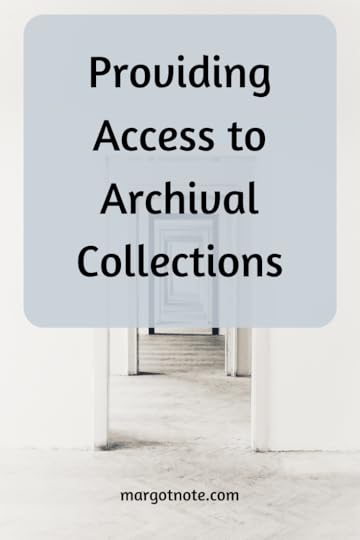
August 23, 2021
Writing a Collection Development Policy
Archives and special collection development policies should state what the organization currently holds and the collecting areas, especially records of enduring value that represent the organizations' history. A policy will not only formalize the archives program, but it will allow you to focus on what you would like to acquire as well as to disregard materials that fall outside of the collection. Focusing on what you will not collect will also allow you to deaccession materials that should not be in the collection.
The policy should be a public document, made available on the organization's website and shared with stakeholders, organizations collecting in similar areas, and with select national and international organizations.
A recent client was preparing to launch a formal archives and special collections program after years of informally collecting materials. After my two-day visit, I wrote an evaluation report to guide their work in setting up the archives with short, mid-range, and long-term goals. Step one was to write and get approved a formal collection development policy, since all other activities stem from this document.
All archives and special collection development policies should consider the following:
Under what authority does your program operate or is governed?
Who makes decisions about what to accept? Major acquisitions may need approval at a high level.
What is the purpose of the program?
What is the history of the program within the organization?
Who is your audience? Who uses your archives and special collections?
What is the focus of the collection? List the subjects, people, timeframes, and geographic areas your program focuses on. Describe the kinds of materials your program collects.
What formats can the repository responsibly manage?
For book collections, what are your policies on editions (firsts, impressions, dust jackets, reprints, paperbacks, translations) and duplicates?
How will materials be accepted into the collections? Will records be actively sought? Will collections be bought and from what funds? Who will approve acceptance of materials? Through what means will legal custody be obtained?
Will loans of materials be made to other organizations and will they be accepted by your organization? Under what circumstances? What are the conditions of the loan and for its termination?
Are you legally required to collect certain kinds of materials?
How do you handle issues of ownership and title, copyright, data protection, and freedom of information? What materials will have limited access because of these issues?
How will you handle preservation issues? Will you take items in poor condition and, if so, under what circumstances?
How does this collection policy fit into the collecting policies of other libraries? Who else collects in your subjects and region? Can you work together for mutual benefit?
Under what authority and circumstances will unwanted materials be removed from the collections? What procedures will be used to document this activity?
How often will the policy be reviewed? Regular review can uncover issues that have caused problems, the impact of new collections, and changes in technologies and practices.
What else should be included? What organizations have particularly well-crafted collection policies?
Get StartedWork with an archival expert. Learn more about how I might help you by clicking the contact button below
Contact
August 16, 2021
9 Reading Strategies for Better Comprehension
There are a variety of reading methods that can help you take in more information, make your efforts more efficient, and save time. A professor in graduate school once told me that students are never expected to complete all the readings; instead, they learn how to prioritize their reading so that they can get the essence of the texts.
Learning that took the pressure off of me to read my texts from cover to cover. I aimed my attention at the parts of the books and articles that would serve me best as a student. With this plan in mind, I found that my retention of knowledge increased and my stress was reduced.
Here are some strategies for reading:
Purpose-LedHaving a purpose for reading is one of the main reading strategies. If you know what information you are looking for in the text, it is easier for you to stay focused. The purpose for reading can vary. It may include finding answers to specific questions, getting an overview, writing a summary, or refreshing your memory of a text or book that was studied in class.
PredictingPredicting means looking at the title, subtitle, visuals, and section titles of a text or chapter and guessing the content. For review, this step can be used to check what can be remembered from the material. Later, you can read the text actively and see whether your predictions were accurate.
OverviewingGetting an overview of a complex text, before reading it in detail, helps to build up a mental outline of the main ideas covered. Read the introduction and conclusion, as well as the first and last sentences of each paragraph. This process allows you to see the bigger picture of the text.
SkimmingSkimming means quick reading—faster than your normal reading speed. The aim is to take in chunks of information and make connections between sections. It is especially useful for the review of texts that have already been read at least once.
ScanningScanning is not really reading. Instead, it involves moving very fast through a text to find a specific piece of information, such as a key phrase, name, or number. This strategy is mostly used when searching for answers to specific questions.
SelectingSelective reading is the process of choosing what to read within a whole text or chapter. Depending on the purpose, you can select specific sections, containing answers to questions or topic-specific details, that need to be reviewed. This strategy is best combined with getting an overview to identify the relevant details.
StrategizingStrategize your reading. Always focus on the core readings. For supplemental readings, focus on readings that make an argument first. Then move on to readings that describe an event or person. Lastly, look at readings that only provide context.
Active ReadingActive reading is a five step process, described in Zachary Shore’s Grad School Essentials: A Crash Course in Scholarly Skills. It’s used to locate and assess the author’s question, thesis, and key evidence. First, analyze the title and subtitle, then scrutinize the table of contents. Read the last section first, looking for the summary of the argument, then read the introduction. Lastly, target the most relevant chapters of the book, or sections of the article.
Post-reviewingReading reviews of the book can help highlight key ideas in the text, especially if the book is well-known or part of the canon of your field. You can try one of the strategies above, then read reviews of the book when it was published (as well as subsequent editions) to see how the book was received over time. Reviews can bring out the major themes of the book, and while review will never replace the act of reading the primary document, it can help provide context.
No matter what strategy you use, keep in mind that reading for work or school should always serve an objective. Save your careful reading for the books you read for pleasure so that you can luxuriate in them and unwind.
Check out some of my favorite books on this subject:
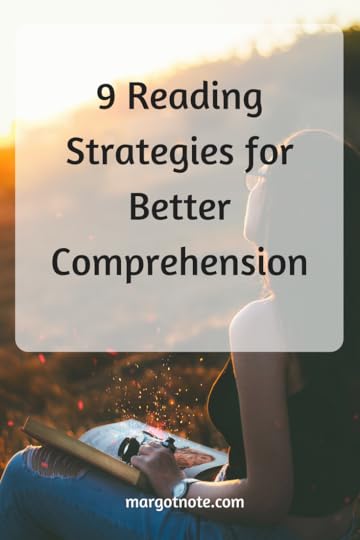
August 9, 2021
Strategies for Better Note-Taking
Note-taking for classes, meetings, studying, or research is a skill you develop over time. Use any note-taking style that works best for you. Experience with different formats, combine them, or improvise to create your style.
As a student, I was always a good note-taker. I had to live up to my last name, of course! Over time, I developed systems to help me document meetings, share ideas, and write books and articles.
Here are some strategies to improve your note-taking habits:
Try note-taking templates available in stores or online. Investigate systems like Cornell Notes or Smart Wisdom, for example.
Experiment to see if prefer to write or type your notes.
Make key points stand out.
Circle, underline, or color-code key words and ideas.
Make notes more concise by leaving out unessential words and by using abbreviations, arrows, and symbols.
Show how ideas are connected, such as by using the mind map style.
Organize notes using boxes, arrows, exclamation marks, and other symbols.
Use colors, highlighters, and visuals, if helpful.
Compare your notes with others studying the same subject; they may have captured information that you haven’t.
Write as if you were capturing information for a friend unfamiliar with your topic. How can you explain the information clearly for future reference? When I was an undergraduate, I earned money taking notes in class for students with learning disabilities. Because I was taking notes for someone else, I made sure to be as clear as possible.
Take notes twice. For example, I write down everything I can capture on the fly for business calls. I later transfer these notes, neatly and better organized, into my business notebook for posterity.
Keep practicing. Note-taking is a skill that requires regular development.
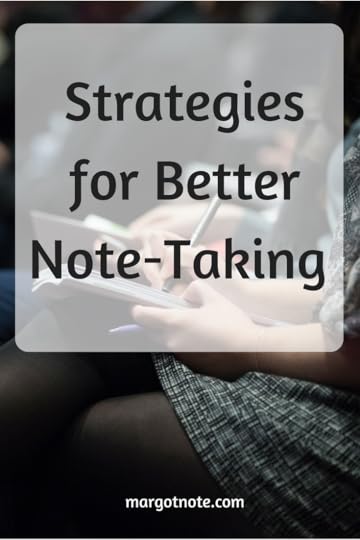
August 2, 2021
Selecting the Right Project
This article is the first part of a series on project management for records managers, published in ProfessioNotes, the newsletter of the Institute of Certified Records Managers (ICRM). The series focuses on six key areas of project management: selection and prioritization, leading and managing teams, planning and scheduling, budgeting and performance, communication and documentation, and completion and review.
Records managers deal with projects all the time, such as developing a records retention schedule, converting files, or designing an automatic records retrieval system. Although each project is different, they all benefit from the discipline of project management.
The beginning of a project is critical to its success, and teams tend to jump into a project too soon. They are excited to start or feel pressure from executive stakeholders to begin the project. In my experience, records managers always benefit from more effort in selecting and prioritizing the projects that will be the most advantageous to their organizations. Careful selecting and pre-planning saves a tremendous amount of time and effort throughout the project’s lifecycle.
"The most vital part of managing a successful project is identifying the right problem to be solved.”[i] Projects need business cases, which justify them based on their expected benefits. The project’s sponsor is the best person to develop the business case because he or she is invested in the project. A sponsor has the clout and emotional intelligence to certify that the project receives the needed resources to complete it. Larger projects require feasibility studies and cost-benefit analysis. These activities are crucial when the project seems unattainable, yet you need proof to petition executives to reconsider their plans.
Success criteria specify how the project is executed. Universal success criteria include finishing the project on schedule, keeping costs within budget, and meeting goals. In records management projects, success criteria is measured differently than most commercial, profit-making projects. Cost reduction, reduced legal liabilities, faster retrievals, and improved services are factors to track.
A proposal is the first step in launching a project. It includes the vision of the work and a plan for its completion. It’s a necessary fiction because it’s an idealized version of what the project could be. Review the proposal if you are mandated to do the work. Proposals written by others to secure funding often exaggerate results. The outcomes you wish to achieve should be attainable.
When you select your project, think about how you could transform it from delivering a suitable solution to something that catches the imagination of those in your field. Suspend judgment on ideas and be inventive. Consider at least three possible approaches, even when there is a clear solution. Your method should always be grounded in the triple constraint of project management—time, cost, and scope—but a creative solution may improve your project and make it more enjoyable for you and your team.
Your approach should also fit the culture of the organization. Forcing a tactic that is alien to organizational culture is a losing battle. Focus on what the company needs which will also match its modus operandi.
With an approach in mind, your team should discuss its implementation. Projects that use new methods or technologies may be questionable. Consider your assumptions and risks. “A reactive project manager attempts to resolve issues when they occur, but a proactive project manager tries to determine problems beforehand.”[ii] You may assume many things throughout the course of a project, but communication with your team will ensure that you don’t keep your presuppositions for long.
Requirements for the project should be thought out, as they lay the foundation for defining the project scope, testing deliverables, and measuring success. The primary reason for project failure is poorly defined requirements.
As a project manager, you must distinguish between essential, desirable, and unnecessary requirements. Be alert for stakeholders who append wish list items into your necessary requirements. Requirements always need to be documented clearly and thoroughly to permit better estimates of your timeline, budget, and resources, and to provide a means to control changes.
The requirements must also address the right problem. If the project was constructed through its requirements to deliver the wrong solution, it might be considered a failure even if everything was delivered on time and within budget and scope. Gathering the appropriate requirements ensures that the project delivers business value and is perceived as a triumph.
A rough draft of the requirements or a prototype of the project can act as a straw man for stakeholders to critique. Use the opportunity to let them articulate their needs. By stating what they don’t want, stakeholders express what they are seeking in the project.
Consider the deliverables of the project. Deliverables are the defined results and services produced or handed over during the project. RIM project deliverables could be a function-based filing scheme for analog and digital records, a user-friendly filing database, or a retention schedule.
A clear understanding of the scope is the foundation on which successful projects are built. Without it, a project manager will struggle to deliver a project. The project scope is the required work, which the project must complete for it to end. The scope statement gives an overview of what to expect throughout the life of the project and what the desired outcomes of the project will be. It specifies tasks and deliverables so that project success can be measured along the way and at project completion. All stakeholders must accept the scope statement before the project progresses.
Avoid the dreaded scope creep—those small, undocumented changes in the project scope. As the project evolves, you may discover implied, infeasible, or extraneous requirements. You may also realize that you overlooked fundamental requisites that you will need to add to the project. (I’ll discuss making changes in a subsequent article). All changes should be put against the requirements to ensure that the project stays on track.
The best way to prove your records management programs’ worth is to complete value-added projects. Records management offers an unlimited number of projects in which project management methodologies should be employed. When working on projects such as developing a vital records program, implementing a legal hold process, or introducing technology, remember that selecting and prioritizing the right project for your organization is your inaugural step to project victory.
[i] Margot Note, Project Management for Information Professionals (New York: Elsevier, 2015), 19.
[ii] Note, Project Management for Information Professionals, 36.
Project Management for Information Professionals By Margot Note Buy on Amazon



